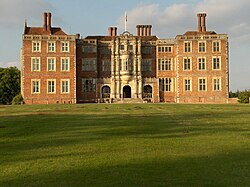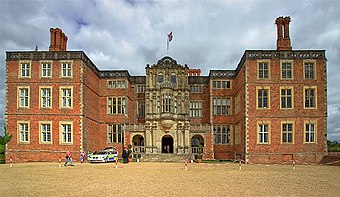Bramshill House: Difference between revisions
Created page with "{{Infobox house |name=Bramshill House |county=Hampshire |picture=BramshillHouse(AndrewSmith)Jun2006.jpg |picture caption=Bramshill House |os grid ref=SU75885963 |latitude=51.3..." |
(No difference)
|
Latest revision as of 19:50, 27 October 2021
| Bramshill House | |
| Hampshire | |
|---|---|
 Bramshill House | |
| Location | |
| Grid reference: | SU75885963 |
| Location: | 51°19’50"N, -0°54’44"W |
| History | |
| Built 1612 | |
| For: | Edward la Zouche |
| Country house | |
| Information | |
Bramshill House stands by Bramshill, in north-eastern Hampshire: it is one of the largest and most important of the Jacobean prodigy houses. Bramshill was built in the early 17th century by Edward la Zouche, the 11th Baron Zouche of Harringworth, but was partly destroyed by fire a few years later. The design shows the influence of the Italian Renaissance, which became popular in Britain during the late 16th century. The house is a Grade I listed building.[1]
The mansion's southern façade is notable for its decorative architecture, which includes at its centre a large oriel window above the principal entrance.
Interior features include a great hall displaying 92 coats of arms on a Jacobean screen, an ornate drawing room, and a gallery 126½ feet long. Numerous columns and friezes are found throughout the mansion, while several rooms have large tapestries depicting historical figures and events on their panelled walls.

The house is set in 262 acres of grounds containing an 18-acre lake. The grounds are themselves Grade II* listed on the Register of Historic Parks and Gardens: they include about 25 acres of early 17th-century formal gardens near the house. The wider mediæval park was landscaped from the 17th to the 20th century and contains woodland.
History
The mano existed by the time of the Domesday Book, 1086, listed as Bromeselle and as held by Hugh de Port.
In the early 14th century, Sir John Foxley was in ownership, as evidenced by grants he made endowing a chapel in Bramshill village. The estate remained in the hands of the Foxley family and their heirs, the Essex family, until 1499, when it was sold to Giles Daubeney, 1st Baron Daubeney, whose son sold it to King Henry VIII. It was sold on by King Edward VI.
In March 1605, Edward la Zouche, 11th Baron Zouche, a favourite of King James VI and I bought the property. Zouche demolished a large part of the building and began to build the Bramshill House of today, completed in 1612. Henry Shaw describes the new house which Zouche built as a "specimen of Elizabethan architecture [which] merits particular attention, exhibiting all the stateliness for which the period referred to was remarkable, with a suite of apartments both large and lofty. The amplitude of its dimensions indicate a princely residence."
During the reign of Kinv Charles I, the house was partly destroyed by a fire. On 25 June 1640, Lord Antrim sold Bramshill for £9,500 to Sir Robert Henley. Sir John Cope purchased the property in 1699, and his descendants occupied the premises until 1935. The Cope family shortened the wings on the south side in 1703, converted most of the chapel to a drawing room and introduced a mezzanine on the west side during the 18th century. They were responsible for much of the interior, with significant renovation work done in the 19th century and in 1920.[2]
Bramshill appears to have been a local sporting and social venue since the 16th century. The cricket ground at the house played host to a first-class match in 1823 when an early Hampshire team played an England XI, and it hosted three other matches in 1825–26.
Later history
In 1935, the house was purchased from the Cope family by Ronald Nall-Cain, 2nd Baron Brocket, the house's last private owner.[3] It was used by the Red Cross as a maternity home during the Second World War, after which it became the home of the exiled King Michael I of Romania and Queen Anne for several years.
The mansion became the location of the Police Staff College in 1960, and later the European Police College. As a result, many campus buildings have been added to the estate.
Owing to escalating maintenance costs the property was sold to the heritage property developers City & Country in August 2014.
Outside links
| ("Wikimedia Commons" has material about House Bramshill House) |
References
- ↑ National Heritage List 1340025: Bramshill House (Grade I listing)
- ↑ Nikolaus Pevsner: The Buildings of England: Hampshire & The Isle of Wight, 1967 Penguin Books ISBN 978-0-300-09606-4
- ↑ Churchill, Penny (25 July 2013). "Jacobean Country Houses for Sale". Country Life. http://www.countrylife.co.uk/property/article/531310/Jacobean-country-houses-for-sale.html.
Bibliography
- Allen, E. W. (28 June 1873). "The Castles, Halls, and Manor Houses of England: Bramshill, Hampshire". The Antiquary 3 (69): 313–15. https://books.google.com/books?id=wuE4AQAAMAAJ&pg=PA313.
- Blunt, Anthony; Lees-Milne, James (2001). "Spread of the Renaissance: England, Tudor and Jacobean". in John Julius Norwich. Great Architecture of the World. Da Capo. pp. 168–69. ISBN 978-0-306-81042-8. https://books.google.com/books?id=Oo2BjGYRIT0C&pg=PA168.
- Borrell, Clive; Cashinella, Brian (1975). Crime in Britain Today. Routledge. ISBN 978-0-7100-8232-9. https://books.google.com/books?id=u6A9AAAAIAAJ&pg=PA176.
- Cecil (1849a). "Notes of the Chase". The Sporting Magazine. https://books.google.com/books?id=DB8GAAAAQAAJ&pg=PA320.
- Cecil (1849b). "Notes of the Chase". The Sporting Review. https://books.google.com/books?id=xYMEAAAAQAAJ&pg=PA424.
- Cecil (January 1852). "The Friends to Fox-Hunting, Both Great and Small". The New Sporting Magazine. https://books.google.com/books?id=3YUEAAAAQAAJ&pg=PA35.
- Cliffe, John Trevor (1999). The World of the Country House in Seventeenth-Century England. Yale. ISBN 978-0-300-07643-1. https://books.google.com/books?id=34lNsEFcProC&pg=PA39.
- Cope, Sir William Henry (1883). Bramshill: Its History & Architecture. London: Infield. OCLC 7444327. http://commons.wikimedia.org/wiki/File:Bramshill,_its_history_and_architecture_(by_Sir_William_H._Cope).pdf.
- Cox, John Charles (1904). Hampshire. The Little Guides. Methuen. p. 85. OCLC 2143241. https://archive.org/details/hampshire00coxgoog.
- Evershed, Henry (1887). "Canon Kingsley as a Naturalist and Country Clergyman". The Living Age 172: 98–104. https://books.google.com/books?id=XoMkAQAAIAAJ&pg=PA103.
- Hirschel, J. David; Wakefield, William; Sasse, Scott (2007). Criminal Justice in England and the United States. Jones and Bartlett. ISBN 978-0-7637-4112-9. https://books.google.com/books?id=RSOSXYYIYVwC&pg=PA125.
- Jeans, George Edward (1906). Memorials of Old Hampshire. Bemrose and Sons. https://archive.org/details/memorialsofoldha00jeanrich.
- Kingsley, Charles (1877). Charles Kingsley: His Letters and Memories of His Life. Edited by His Wife. Scribner, Armstrong and Co.. https://books.google.com/books?id=jPwHAQAAIAAJ&pg=PA438.
- Kingsley, Rose G. (1885). "The Children of Westminster Abbey". in Pratt, Ella Farman; Pratt, Charles Trowbridge. Wide Awake. 21. D. Lothrop. https://books.google.com/books?id=mvI1AQAAMAAJ&pg=RA2-PA129.
- Legg, Penny (2010). Folklore of Hampshire. The History Press. ISBN 978-0-7524-5179-4. https://books.google.com/books?id=BqGaSQAACAAJ.
- Charles Edward Long (1843). "Church Notes on Hampshire". Collectanea Topographica et Genealogica 8: 43–66. https://books.google.com/books?id=LSrfVSLKTlQC.
- Page, William, ed (1911). "Parishes: Eversley". A History of the County of Hampshire. 4. Constable & Co.. http://www.british-history.ac.uk/report.aspx?compid=56741.
- Pevsner, Nikolaus; Lloyd, David Wharton (1967). Hampshire and the Isle of Wight. The Buildings of England. 32. Penguin. OCLC 484927.
- Ribblesdale, Baron Thomas Lister; Burrows, Edward (1897). The Queen's Hounds and Stag-hunting Recollections. Longmans, Green & Co.. p. 160. https://archive.org/details/queenshoundsand00ribbgoog.
- Sager, Peter (1996) (in de). Südengland: von Kent bis Cornwall: Architektur und Landschaft, Literatur und Geschichte. DuMont Kunst-Reiseführer. DuMont. ISBN 978-3-7701-3498-4. https://books.google.com/books?id=Icv8yLyEFm8C&q=begutachtete+unter+anderem+Bramshill+House.
- Salvan, George Salinda (2005). Architectural Character & The History of Architecture (3rd ed.). Goodwill Trading. ISBN 978-971-12-0262-0. https://books.google.com/books?id=aDdjw1DiKLoC&pg=PA497.
- Shaw, Henry (1839). Details of Elizabethan Architecture. (Elizabethan Architecture and its ornamental details. By T. Moule). William Pickering. p. 34. OCLC 620865. https://archive.org/details/detailsofelizabe00shaw.
- Smith, John (1887). "On the Present State and Future Prospects of Arboriculture in Hampshire". Scottish Forestry Journal 11: 511–44. https://books.google.com/books?id=8vEbAQAAMAAJ&pg=PA544.
- Tanner, Henry; Galsworthy Davie, W. (1903). Old English Doorways: A series of historical examples from Tudor times to the end of the XVIII century. B. T. Batsford. p. 15. https://archive.org/details/oldenglishdoorw00davigoog.
- Tripp, Miles (2002). The Eighth Passenger: A Flight of Recollection and Discovery. Wordsworth. ISBN 978-1-84022-252-4. https://books.google.com/books?id=euyM8XEBL3oC&pg=PA134.
